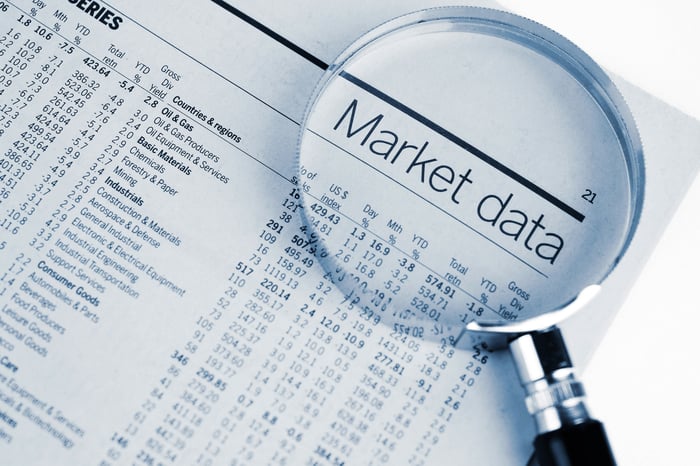If you've ever played the board game Chutes and Ladders and landed on space 87, which throws the player back 63 spaces, you might have some idea of what it's been like to be a Valeant Pharmaceuticals (BHC 1.05%) shareholder over the past two years. The only difference is that Valeant has hit this proverbial chute on space 87 that's sent it screaming backward over and over again.
Shares of the embattled drugmaker are down well over 90%, and more than $80 billion in market cap, since their peak in August 2015. What was once a company that thrived from increasing the price of its drugs, and boosted growth via debt-financed acquisitions, is now struggling to pass along inflation-topping price increases and has had its merger-and-acquisition growth engine come to a grinding halt.

Image source: Getty Images.
CEO Joe Papa has spent about a year orchestrating strategies to reduce the company's burdensome debt load, which once topped $32 billion, and to reignite its core businesses, which primarily consist of Bausch & Lomb and Salix Pharmaceuticals, a drugmaker focused on gastrointestinal ailments.
Say what? Valeant actually showed signs of improvement
While flashes of hope have arisen from time to time, they've often been dashed by an earnings report more miserable than the last. Needless to say, hope wasn't too high heading into Valeant's second-quarter results that we'd see a noticeable turnaround. However, that's exactly what Wall Street and investors received. Three figures, in particular, stand out as being notably optimistic in Valeant's Q2 report.
1. Bausch & Lomb's organic growth rate
Bausch & Lomb could arguably be described as Valeant's foundation. It's the one business segment that's maintained strong pricing power and hasn't seen sales slide dramatically during its downturn.
In the latest quarter, reported sales fell 3%, but this doesn't tell the whole story. If we strip out currency fluctuations in international markets, Bausch & Lomb's sales growth increases to 1% year over year. But we're still not done. We also have to account for Valeant's skincare divestitures earlier this year, which wound up raising cash to reduce its debt. If we merely look at the apples-to-apples comparison of what products were there both last year and this year, organic sales grew 6%. This is essentially right in line with management's expected growth rate for Bausch & Lomb in 2017. That's great news.

Image source: Getty Images.
2. Salix Pharmaceuticals' organic growth rate
Valeant ponied up a small fortune (about $11 billion) to acquire Salix Pharmaceuticals in 2015, with the hope that it would continue a recent streak of phenomenal top- and bottom-line growth. However, the uptake of Salix's therapies hasn't been anywhere close to expectations... till now.
In the second quarter, branded Rx sales, which includes Salix and other indications, fell 3%. However, if we strip out the divestiture of Ruconest, organic growth for branded Rx was flat in the second quarter compared to the year-ago period. But it gets even better for Salix, where organic growth, exclusive of the Ruconest divestment, hit 16% year over year, fueled by a 17% increase in Xifaxan sales. One quarter does not make a trend, but this was Salix's strongest performance in quite some time.
3. Valeant's EBITDA-to-interest coverage ratio
Perhaps most importantly, for the first time in well over a year we saw the company's EBITDA (earnings before interest, taxes, depreciation, and amortization)-to-interest coverage ratio increase from the sequential quarter.

Image source: Getty Images.
As you probably are aware, Valeant is lugging around a lot of debt -- $28.46 billion listed as of June 30. It's worth noting that it used $811 billion from its Dendreon divestiture to pay down debt since the end of the quarter and has a $930 million sale of iNova Pharmaceuticals, and $190 million sale of Obagi Medical Products, waiting to close. The EBITDA-to-interest coverage ratio is a measurement that Valeant's secured lenders use to gauge the safety of their loans.
During the second quarter, Valeant reported $951 million in EBITDA, representing a double-digit percentage increase from the sequential first quarter. Conversely, it recorded $456 million in interest and fees to service its debt, down about 3% from the first quarter. This ratio works out to 2.08-to-1, and it's notably higher than the 1.83-to-1 recorded in the first quarter. In other words, Valeant's debt covenants may be safe after all.
But before you get too excited...
In many respects, this was exactly the quarter that long-term shareholders were hoping for. The company's two core brands are beginning to show signs of life, and the company's debt covenant ratio is headed in the right direction. But before you get too excited and decide to rush out to buy what looks like a dirt cheap stock, keep in mind that Valeant still has a very long way to go to resolve its numerous issues.

Image source: Getty Images.
For example, Papa said during the conference call that Valeant was done with its non-core asset divestitures in the interim. It'll instead focus on growing its existing business and utilizing operating cash flow to pay down debt. That still leaves the company with somewhere around $26.5 billion in debt by the end of the year and, my guess, around $435 million to $440 million in quarterly debt-servicing costs. Can Valeant really make headway on its debt through organic pay down? I'm not sure, given its recent reliance on asset sales to drive debt reduction.
Also, even with debt maturity dates pushed out, and no meaningful debt due until 2020, the EBITDA-to-interest coverage ratio is still exceptionally low. Even with the company making its payments on time, it could still default on its debt, triggering the need for a rapid repayment, if this ratio dips below 1.5-to-1. Just because this ratio reversed in the second quarter doesn't mean the downward trend is fully broken.
We're also still seeing plenty of pockets of weakness in the underlying business. Dermatology and dentistry sales plunged 31% and 22%, respectively, in the second quarter, while U.S. diversified product sales, partly affected by divestitures, sank 27%!
Valeant Pharmaceuticals remains nothing more than a lottery-ticket investment at this point, and this Fool can think of far better stocks to park your money in.





